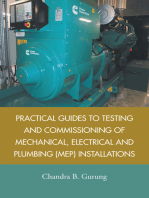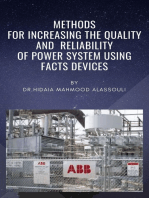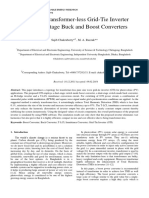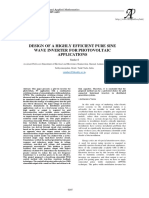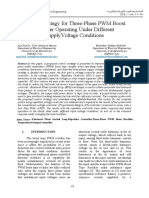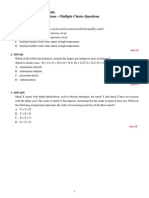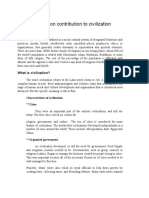Three Level Boost Paper
Uploaded by
RekhamtrThree Level Boost Paper
Uploaded by
RekhamtrAdvanced Science and Technology Letters
Vol.51 (CES-CUBE 2014), pp.68-72
http://dx.doi.org/10.14257/astl.2014.51.16
Three-Level Boost Converter Design for High
Efficiency Photovoltaic Power Conditioning System
Jinsoo Kim, Oh Yang
Electronic Engineering of Cheongju University, Korea
jinsoa@gmail.com, ohyang@cju.ac.kr
Abstract. This paper proposes the three-level boost converter for highefficiency photovoltaic power conditioning system. Different from the existing
two-level high boost converter, it has the advantage of high voltage gain and
thus it is easy to make a high voltage from a low voltage. The proposed threelevel boost converter reduces the reverse recovery losses of the diodes and
increases the overall power efficiency. Experimental results show the high
performance for a 4kW resistive load and grid-connected power condition
system.
Keywords: Three-Level Boost Converter, Photovoltaic Power Conditioning
System, PV PCS
Introduction
Nowadays the alternative energy researches are constantly performed due to the
environmental pollution and the depletion of fossil fuels, and particularly the
photovoltaic research is constantly underway. Photovoltaic power system is mainly to
be used in grid-connected system. Photovoltaic power system consists of the gridconnected inverter and the boost converter to earn a high output voltage from the low
output voltage of solar power system [1].
The conventional two-level solar inverter is to implement as it has a simple
structure and the already proven control and PWM technique. However, it also has the
disadvantage to contain higher harmonics in the inverter output voltage and it has the
high reverse recovery losses of diodes and increases the overall power efficiency.
However, the three-level solar inverter requires somewhat more complex PWM
technique than the two-level solar inverter, but it has the benefit to reduce harmonic
content. In addition, it has the disadvantages to require a mid-point of the DC link and
the controller to control the mid-point voltage separately [2-4].
The boost converter is ideally to infinite voltage gain but has the limit to raise the
voltage by more than 5-6 times in practice due to the equivalent series resistance of
the inductor. This paper is to implement the PWM method and the controller of threelevel boost converter which has the higher voltage advantage than the conventional 2level boost converter. In order to verify the proposed three level boost converter, this
paper is devoted through the resistance load variation experiment and the gridconnected experiment.
ISSN: 2287-1233 ASTL
Copyright 2014 SERSC
Advanced Science and Technology Letters
Vol.51 (CES-CUBE 2014)
Proposed Three Level Boost Converter
L1
Ii
D1
S1
Vin
Co1
Vo1
Ci
Vo
Vo 2
Co 2
S2
Fig. 1. Schematic of three level boost converter
Fig. 1 shows the circuit diagram of a three level boost converter proposed in this
paper. The development trend of photovoltaic PCS is valuing the increase of the
capacity and high performance and efficacy. Comparing the proposed three-level
boost converter with the conventional two-level converter, three-level converter has
the advantages that the voltage gain is increased doubled, and the voltage across the
switching element and a diode is to be halved. Also, it has the advantage to
equivalently maintain the output voltages of V and V by controlling the midpoint and to realize the multi-level inverter.
o1
Main Boost Controller
Vo _ ref +
o2
KP
PWM Generator
d1
S1
Ki
Vo
Midpoint Contoller
d peak
d2
S2
KP
Vo1 Vo 2
d1 d
Ki
Fig. 2. Block diagram of the purposed boost converter controller
Fig. 2 shows the controller of boost converter proposed in this paper. Boost
converter has two controllers and one PWM generator. The main boost controller
controls the output voltage V by using PI controller which is widely used in the
o
Copyright 2014 SERSC
69
Advanced Science and Technology Letters
Vol.51 (CES-CUBE 2014)
automation system. Usually the voltage unbalances between V and V can occur.
To reduce this voltage unbalance, the difference between two voltages is to be
controlled to 0 through PI controller. Finally, PWM is generated by using d and
o1
o2
generated from the controller. Fig. 3 shows the major waveforms for three-level
boost converter proposed in this paper.
d2
d1
d2
d2
d1
S1
S1
S2
S2
Ii
Ii
(a)
(a) 0 . 5
(b)
d1 1
or
Vi
Vo
(b) 0
d 1 0 .5
or
Vi
Vo
2
Fig. 3. Key waveform of the proposed three level boost converter
Experimental Results and Discussions
3.1 Resistance load variation experiment result
Ch1 [100V/div.] Ch2 [10V/div.] Ch3 [100V/div.]
Ch1 : Vo1
Ch1 : Vo1
Ch2 : Vo1-Vo2
Ch2 : Vo1-Vo2
Ch3 : Vo2
Ch3 : Vo2
Time [1s/div.]
Ch1 [100V/div.] Ch2 [10V/div.] Ch3 [100V/div.]
(a)
Time [1s/div.]
(b)
Fig. 4. Waveform of resistance load variation experiment
Fig. 4 shows the boost converting from 320 V to 650 V by using the boost
converter proposed in this paper. And the output voltage of V and V was
connected to 250 load resistor. (A) Waveform is the one to be observed its output
voltage by changing the V resistor load to 166 load resistor. (B) Waveform is the
o1
o2
o1
one to be observed its output voltage by changing the
70
Vo2
resistor load to 166. All
Copyright 2014 SERSC
Advanced Science and Technology Letters
Vol.51 (CES-CUBE 2014)
of these two waveforms can be observed swaying mid-point in the initial stage.
However, it was verified that the original voltage resumed to the normal voltage
within 100ms.
3.2 Grid-connected experiment result
Grid Conneted
Ch1 : Vo1
Ch2 : Vo1+Vo2
Ch3 : Vo2
Ch4 : Io
Ch1 [100V/div.]
Ch2 [10V/div.] Ch3 [100V/div.]
Ch4 [5A/div.]
Time [1s/div.]
Fig. 5. Waveform of grid-connected experiment
The waveform of Fig. 5 is the observed result of the boost converter output voltage
when it is connected with the grid. As experimental result of the output current of the
inverter system up to 5A, at the time that the relay is turned on it was observed a little
bit shaky. However, it was verified to return to the normal voltage range within
500ms.
Conclusion
This paper proposes three-level boost converter for high-efficiency solar inverter. The
proposed boost converter was set to control the algorithm by one triangular wave,
which was controlled by two conventional triangular waves. The boost converter
proposed in this paper could be verified through the resistive load experiment and the
grid-connection experiment. Experimental results show the high performance for a
4kW resistive load and grid-connected power condition system.
Acknowledgment. This work (Grants No. 2013-06) was supported by Business
for Cooperative R&D between Industry, Academy, and Research Institute funded
Korea Small and Medium Business Administration in 2013.
Copyright 2014 SERSC
71
Advanced Science and Technology Letters
Vol.51 (CES-CUBE 2014)
References
1. Velaerts, M.: New Developments of 3-Level PWM Strategies, European Conf. on Power
Electronics and Applications (1989)
2. Apeldoorn, O., Schulting, L.: 10 kVA Four Level Inverter with symmetrical Input Voltage
Distribution, European Conf. on Power Electronics and Applications (1993)
3. Haddad, K.: Three level DC-DC converters as efficient interface in two stage PV power
systems, Energy tech, (2012)
4. Kwon, J. M., Kwon, B.H.: Three-Phase Photovoltaic System with Three-Level Boosting
MPPT Control, IEEE Trans. on power electronics, vol. 23, no.5 pp. 2319~2327.
72
Copyright 2014 SERSC
You might also like
- Practical Guides to Testing and Commissioning of Mechanical, Electrical and Plumbing (Mep) InstallationsFrom EverandPractical Guides to Testing and Commissioning of Mechanical, Electrical and Plumbing (Mep) Installations4/5 (4)
- Conversion To Christianity Among The Nagas100% (4)Conversion To Christianity Among The Nagas44 pages
- A Novel Topology For Single-Inductor Single Input Triple Output DC-DC Power ConverterNo ratings yetA Novel Topology For Single-Inductor Single Input Triple Output DC-DC Power Converter7 pages
- Novel DC-DC Multilevel Boost Converter: Julio C. Rosas-Caro, Juan M. Ramírez, Pedro Martín García-ViteNo ratings yetNovel DC-DC Multilevel Boost Converter: Julio C. Rosas-Caro, Juan M. Ramírez, Pedro Martín García-Vite6 pages
- (3L) Single-Phase Three-Level Boost Power Factor Correction ConverterNo ratings yet(3L) Single-Phase Three-Level Boost Power Factor Correction Converter6 pages
- It Is Quite Another Electricity: Transmitting by One Wire and Without GroundingFrom EverandIt Is Quite Another Electricity: Transmitting by One Wire and Without GroundingNo ratings yet
- Simulation of Some Power System, Control System and Power Electronics Case Studies Using Matlab and PowerWorld SimulatorFrom EverandSimulation of Some Power System, Control System and Power Electronics Case Studies Using Matlab and PowerWorld SimulatorNo ratings yet
- An Advanced Two Level Double Dual Boost ConverterNo ratings yetAn Advanced Two Level Double Dual Boost Converter5 pages
- Reference Guide To Useful Electronic Circuits And Circuit Design Techniques - Part 1From EverandReference Guide To Useful Electronic Circuits And Circuit Design Techniques - Part 12.5/5 (3)
- An Improved Multilevel Inverter For Single Phase TransformerlessNo ratings yetAn Improved Multilevel Inverter For Single Phase Transformerless10 pages
- Four-Level_Single-Stage_Single-Source_Boost-InverterNo ratings yetFour-Level_Single-Stage_Single-Source_Boost-Inverter19 pages
- Multi-Modular Multi-Level Pulse Width Modulated Inverters: Mon W LNo ratings yetMulti-Modular Multi-Level Pulse Width Modulated Inverters: Mon W L6 pages
- A New Symmetric Multilevel Inverter Topology Using Single and Double Source Sub-Multilevel InvertersNo ratings yetA New Symmetric Multilevel Inverter Topology Using Single and Double Source Sub-Multilevel Inverters10 pages
- Design and Simulation of Boost Converters Suitable For Photo Voltaic ApplicationsNo ratings yetDesign and Simulation of Boost Converters Suitable For Photo Voltaic Applications9 pages
- Analysis, Design, and Control of Standalone PV Based Boost DC-AC ConverterNo ratings yetAnalysis, Design, and Control of Standalone PV Based Boost DC-AC Converter9 pages
- Methods for Increasing the Quality and Reliability of Power System Using FACTS DevicesFrom EverandMethods for Increasing the Quality and Reliability of Power System Using FACTS DevicesNo ratings yet
- High FQ Link of Asymetry Inverter ModelNo ratings yetHigh FQ Link of Asymetry Inverter Model32 pages
- Design and Analysis of A Transformer-Less Single-Phase Grid-Tie Photovoltaic Inverter Using Boost Converter With Immittance Conversion TopologyNo ratings yetDesign and Analysis of A Transformer-Less Single-Phase Grid-Tie Photovoltaic Inverter Using Boost Converter With Immittance Conversion Topology8 pages
- Ijert Ijert: Novel DC-DC Converter For PV System With High Voltage GainNo ratings yetIjert Ijert: Novel DC-DC Converter For PV System With High Voltage Gain7 pages
- A Multilevel Boost Inverter With Removed Leakage Current and A Reduced Number of Elements For Photovoltaic ApplicationsNo ratings yetA Multilevel Boost Inverter With Removed Leakage Current and A Reduced Number of Elements For Photovoltaic Applications11 pages
- Design of A Highly Efficient Pure Sine Wave Inverter For Photovoltaic ApplicationsNo ratings yetDesign of A Highly Efficient Pure Sine Wave Inverter For Photovoltaic Applications8 pages
- 22-08-2022-1661167991-6-.-1. Engg - Comparison of Single Switched Cascaded Converter and Boost Converter in Optimizing The Use of Solar PanelsNo ratings yet22-08-2022-1661167991-6-.-1. Engg - Comparison of Single Switched Cascaded Converter and Boost Converter in Optimizing The Use of Solar Panels8 pages
- A SiC-based T-Type Three-Phase Three-Level Gridtied InverterNo ratings yetA SiC-based T-Type Three-Phase Three-Level Gridtied Inverter6 pages
- Power Systems-On-Chip: Practical Aspects of DesignFrom EverandPower Systems-On-Chip: Practical Aspects of DesignBruno AllardNo ratings yet
- Boost Inverter Circuit With A Coupled Inductor Using Renewable Energy SourceNo ratings yetBoost Inverter Circuit With A Coupled Inductor Using Renewable Energy Source8 pages
- Modified Multilevel Inverter Topology For Grid Connected PV SystemsNo ratings yetModified Multilevel Inverter Topology For Grid Connected PV Systems7 pages
- Multi-Level DC-DC Converter For High Gain ApplicationsNo ratings yetMulti-Level DC-DC Converter For High Gain Applications9 pages
- A Two-Stage Isolated AC-DC Converter For More Electric AircraftNo ratings yetA Two-Stage Isolated AC-DC Converter For More Electric Aircraft6 pages
- A Modified Quadratic Boost Converter Wit PDF100% (1)A Modified Quadratic Boost Converter Wit PDF6 pages
- Comparison of dual isolated converters with flyback converters for bidirectional energy transferNo ratings yetComparison of dual isolated converters with flyback converters for bidirectional energy transfer9 pages
- A Novel Step-Up Single Source Multilevel Inverter: Topology, Operating Principle and ModulationNo ratings yetA Novel Step-Up Single Source Multilevel Inverter: Topology, Operating Principle and Modulation5 pages
- Total Harmonics Distortion Investigation in Multilevel InvertersNo ratings yetTotal Harmonics Distortion Investigation in Multilevel Inverters8 pages
- Double Boost Power-Decoupling Topology Suitable For Low-Voltage Photovoltaic Residential Applications Using Sliding-Mode Impedance-Shaping ControllerNo ratings yetDouble Boost Power-Decoupling Topology Suitable For Low-Voltage Photovoltaic Residential Applications Using Sliding-Mode Impedance-Shaping Controller13 pages
- Improved Three-Phase, Five-Level Pulse-Width Modulation Switched VsiNo ratings yetImproved Three-Phase, Five-Level Pulse-Width Modulation Switched Vsi12 pages
- Novel Nonisolated High-Voltage Gain DC–DC Converters Based on 3SSC and VMCNo ratings yetNovel Nonisolated High-Voltage Gain DC–DC Converters Based on 3SSC and VMC11 pages
- Simulation of Photovoltaic Based Grid Connected Micro Inverter Using CUK ConverterNo ratings yetSimulation of Photovoltaic Based Grid Connected Micro Inverter Using CUK Converter7 pages
- Control Strategy For Three-Phase PWM Boost Rectifier Operating Under Different Supplyvoltage ConditionsNo ratings yetControl Strategy For Three-Phase PWM Boost Rectifier Operating Under Different Supplyvoltage Conditions18 pages
- simulation double level with MGWO-PI-PWMNo ratings yetsimulation double level with MGWO-PI-PWM12 pages
- Lecture Notes: Neural Network & Fuzzy LogicNo ratings yetLecture Notes: Neural Network & Fuzzy Logic82 pages
- Impedance-Source Networks For Electric Power Conversion Part I: A Topological ReviewNo ratings yetImpedance-Source Networks For Electric Power Conversion Part I: A Topological Review18 pages
- Solving Differential Equation Using OPAMPNo ratings yetSolving Differential Equation Using OPAMP4 pages
- Buzzer Interfacing With PIC MicrocontrollerNo ratings yetBuzzer Interfacing With PIC Microcontroller2 pages
- Zero Voltage Switching Resonant Power Devices by Bill AndrecakNo ratings yetZero Voltage Switching Resonant Power Devices by Bill Andrecak28 pages
- Positive Sequence and Zero Sequence Impedance of Transmission Lines Play A Central Role in Distance Protection and Fault LocationsNo ratings yetPositive Sequence and Zero Sequence Impedance of Transmission Lines Play A Central Role in Distance Protection and Fault Locations7 pages
- DC-DC Boost Converter For Custom Application by LeenaNo ratings yetDC-DC Boost Converter For Custom Application by Leena4 pages
- UJT-Uni Junction Transistors: Construction of A UJTNo ratings yetUJT-Uni Junction Transistors: Construction of A UJT9 pages
- Biomedical Instrumentation Syllabus of Pondicherry UniversityNo ratings yetBiomedical Instrumentation Syllabus of Pondicherry University1 page
- Dell PowerEdge R730 and R730xd Technical Guide v1 7 CompressedNo ratings yetDell PowerEdge R730 and R730xd Technical Guide v1 7 Compressed66 pages
- CFD Modeling and Approaches For Calculating The Losses of A Subsea Pipeline Transporting HighPressurized FluidNo ratings yetCFD Modeling and Approaches For Calculating The Losses of A Subsea Pipeline Transporting HighPressurized Fluid7 pages
- African Daisy Orange: Dimorpotheca Greek Dis (Twice) + Morphe (Shape) + Theka (A Fruit)No ratings yetAfrican Daisy Orange: Dimorpotheca Greek Dis (Twice) + Morphe (Shape) + Theka (A Fruit)11 pages
- DBM CSC Form No. 1 Position Description Forms BlankNo ratings yetDBM CSC Form No. 1 Position Description Forms Blank1 page
- ALMCO Risk Assessment Kitchen & Dinning Area-JAN 2021No ratings yetALMCO Risk Assessment Kitchen & Dinning Area-JAN 202110 pages
- [Ebooks PDF] download The Event Manager s Bible How to Plan and Deliver an Event 2nd Edition Des Conway full chapters100% (8)[Ebooks PDF] download The Event Manager s Bible How to Plan and Deliver an Event 2nd Edition Des Conway full chapters85 pages
- Religion's Contribution To Civilization-1No ratings yetReligion's Contribution To Civilization-112 pages
- ALGEBRAIC EXPRESSIONS Term 2 Lesson 7 Grade 8No ratings yetALGEBRAIC EXPRESSIONS Term 2 Lesson 7 Grade 85 pages
- Peace Corps OST Focus In/Train Up (FITU) Focus in - Train Up Action PlanNo ratings yetPeace Corps OST Focus In/Train Up (FITU) Focus in - Train Up Action Plan2 pages
- Practical Guides to Testing and Commissioning of Mechanical, Electrical and Plumbing (Mep) InstallationsFrom EverandPractical Guides to Testing and Commissioning of Mechanical, Electrical and Plumbing (Mep) Installations
- A Novel Topology For Single-Inductor Single Input Triple Output DC-DC Power ConverterA Novel Topology For Single-Inductor Single Input Triple Output DC-DC Power Converter
- Novel DC-DC Multilevel Boost Converter: Julio C. Rosas-Caro, Juan M. Ramírez, Pedro Martín García-ViteNovel DC-DC Multilevel Boost Converter: Julio C. Rosas-Caro, Juan M. Ramírez, Pedro Martín García-Vite
- (3L) Single-Phase Three-Level Boost Power Factor Correction Converter(3L) Single-Phase Three-Level Boost Power Factor Correction Converter
- It Is Quite Another Electricity: Transmitting by One Wire and Without GroundingFrom EverandIt Is Quite Another Electricity: Transmitting by One Wire and Without Grounding
- Simulation of Some Power System, Control System and Power Electronics Case Studies Using Matlab and PowerWorld SimulatorFrom EverandSimulation of Some Power System, Control System and Power Electronics Case Studies Using Matlab and PowerWorld Simulator
- Reference Guide To Useful Electronic Circuits And Circuit Design Techniques - Part 1From EverandReference Guide To Useful Electronic Circuits And Circuit Design Techniques - Part 1
- An Improved Multilevel Inverter For Single Phase TransformerlessAn Improved Multilevel Inverter For Single Phase Transformerless
- Four-Level_Single-Stage_Single-Source_Boost-InverterFour-Level_Single-Stage_Single-Source_Boost-Inverter
- Multi-Modular Multi-Level Pulse Width Modulated Inverters: Mon W LMulti-Modular Multi-Level Pulse Width Modulated Inverters: Mon W L
- A New Symmetric Multilevel Inverter Topology Using Single and Double Source Sub-Multilevel InvertersA New Symmetric Multilevel Inverter Topology Using Single and Double Source Sub-Multilevel Inverters
- Design and Simulation of Boost Converters Suitable For Photo Voltaic ApplicationsDesign and Simulation of Boost Converters Suitable For Photo Voltaic Applications
- Analysis, Design, and Control of Standalone PV Based Boost DC-AC ConverterAnalysis, Design, and Control of Standalone PV Based Boost DC-AC Converter
- Methods for Increasing the Quality and Reliability of Power System Using FACTS DevicesFrom EverandMethods for Increasing the Quality and Reliability of Power System Using FACTS Devices
- Design and Analysis of A Transformer-Less Single-Phase Grid-Tie Photovoltaic Inverter Using Boost Converter With Immittance Conversion TopologyDesign and Analysis of A Transformer-Less Single-Phase Grid-Tie Photovoltaic Inverter Using Boost Converter With Immittance Conversion Topology
- Ijert Ijert: Novel DC-DC Converter For PV System With High Voltage GainIjert Ijert: Novel DC-DC Converter For PV System With High Voltage Gain
- A Multilevel Boost Inverter With Removed Leakage Current and A Reduced Number of Elements For Photovoltaic ApplicationsA Multilevel Boost Inverter With Removed Leakage Current and A Reduced Number of Elements For Photovoltaic Applications
- Design of A Highly Efficient Pure Sine Wave Inverter For Photovoltaic ApplicationsDesign of A Highly Efficient Pure Sine Wave Inverter For Photovoltaic Applications
- 22-08-2022-1661167991-6-.-1. Engg - Comparison of Single Switched Cascaded Converter and Boost Converter in Optimizing The Use of Solar Panels22-08-2022-1661167991-6-.-1. Engg - Comparison of Single Switched Cascaded Converter and Boost Converter in Optimizing The Use of Solar Panels
- Analog Dialogue, Volume 45, Number 2: Analog Dialogue, #2From EverandAnalog Dialogue, Volume 45, Number 2: Analog Dialogue, #2
- A SiC-based T-Type Three-Phase Three-Level Gridtied InverterA SiC-based T-Type Three-Phase Three-Level Gridtied Inverter
- Power Systems-On-Chip: Practical Aspects of DesignFrom EverandPower Systems-On-Chip: Practical Aspects of Design
- Boost Inverter Circuit With A Coupled Inductor Using Renewable Energy SourceBoost Inverter Circuit With A Coupled Inductor Using Renewable Energy Source
- Modified Multilevel Inverter Topology For Grid Connected PV SystemsModified Multilevel Inverter Topology For Grid Connected PV Systems
- Multi-Level DC-DC Converter For High Gain ApplicationsMulti-Level DC-DC Converter For High Gain Applications
- A Two-Stage Isolated AC-DC Converter For More Electric AircraftA Two-Stage Isolated AC-DC Converter For More Electric Aircraft
- Comparison of dual isolated converters with flyback converters for bidirectional energy transferComparison of dual isolated converters with flyback converters for bidirectional energy transfer
- A Novel Step-Up Single Source Multilevel Inverter: Topology, Operating Principle and ModulationA Novel Step-Up Single Source Multilevel Inverter: Topology, Operating Principle and Modulation
- Total Harmonics Distortion Investigation in Multilevel InvertersTotal Harmonics Distortion Investigation in Multilevel Inverters
- Double Boost Power-Decoupling Topology Suitable For Low-Voltage Photovoltaic Residential Applications Using Sliding-Mode Impedance-Shaping ControllerDouble Boost Power-Decoupling Topology Suitable For Low-Voltage Photovoltaic Residential Applications Using Sliding-Mode Impedance-Shaping Controller
- Improved Three-Phase, Five-Level Pulse-Width Modulation Switched VsiImproved Three-Phase, Five-Level Pulse-Width Modulation Switched Vsi
- Novel Nonisolated High-Voltage Gain DC–DC Converters Based on 3SSC and VMCNovel Nonisolated High-Voltage Gain DC–DC Converters Based on 3SSC and VMC
- Simulation of Photovoltaic Based Grid Connected Micro Inverter Using CUK ConverterSimulation of Photovoltaic Based Grid Connected Micro Inverter Using CUK Converter
- Control Strategy For Three-Phase PWM Boost Rectifier Operating Under Different Supplyvoltage ConditionsControl Strategy For Three-Phase PWM Boost Rectifier Operating Under Different Supplyvoltage Conditions
- Impedance-Source Networks For Electric Power Conversion Part I: A Topological ReviewImpedance-Source Networks For Electric Power Conversion Part I: A Topological Review
- Zero Voltage Switching Resonant Power Devices by Bill AndrecakZero Voltage Switching Resonant Power Devices by Bill Andrecak
- Positive Sequence and Zero Sequence Impedance of Transmission Lines Play A Central Role in Distance Protection and Fault LocationsPositive Sequence and Zero Sequence Impedance of Transmission Lines Play A Central Role in Distance Protection and Fault Locations
- DC-DC Boost Converter For Custom Application by LeenaDC-DC Boost Converter For Custom Application by Leena
- UJT-Uni Junction Transistors: Construction of A UJTUJT-Uni Junction Transistors: Construction of A UJT
- Biomedical Instrumentation Syllabus of Pondicherry UniversityBiomedical Instrumentation Syllabus of Pondicherry University
- Dell PowerEdge R730 and R730xd Technical Guide v1 7 CompressedDell PowerEdge R730 and R730xd Technical Guide v1 7 Compressed
- CFD Modeling and Approaches For Calculating The Losses of A Subsea Pipeline Transporting HighPressurized FluidCFD Modeling and Approaches For Calculating The Losses of A Subsea Pipeline Transporting HighPressurized Fluid
- African Daisy Orange: Dimorpotheca Greek Dis (Twice) + Morphe (Shape) + Theka (A Fruit)African Daisy Orange: Dimorpotheca Greek Dis (Twice) + Morphe (Shape) + Theka (A Fruit)
- DBM CSC Form No. 1 Position Description Forms BlankDBM CSC Form No. 1 Position Description Forms Blank
- ALMCO Risk Assessment Kitchen & Dinning Area-JAN 2021ALMCO Risk Assessment Kitchen & Dinning Area-JAN 2021
- [Ebooks PDF] download The Event Manager s Bible How to Plan and Deliver an Event 2nd Edition Des Conway full chapters[Ebooks PDF] download The Event Manager s Bible How to Plan and Deliver an Event 2nd Edition Des Conway full chapters
- Peace Corps OST Focus In/Train Up (FITU) Focus in - Train Up Action PlanPeace Corps OST Focus In/Train Up (FITU) Focus in - Train Up Action Plan


